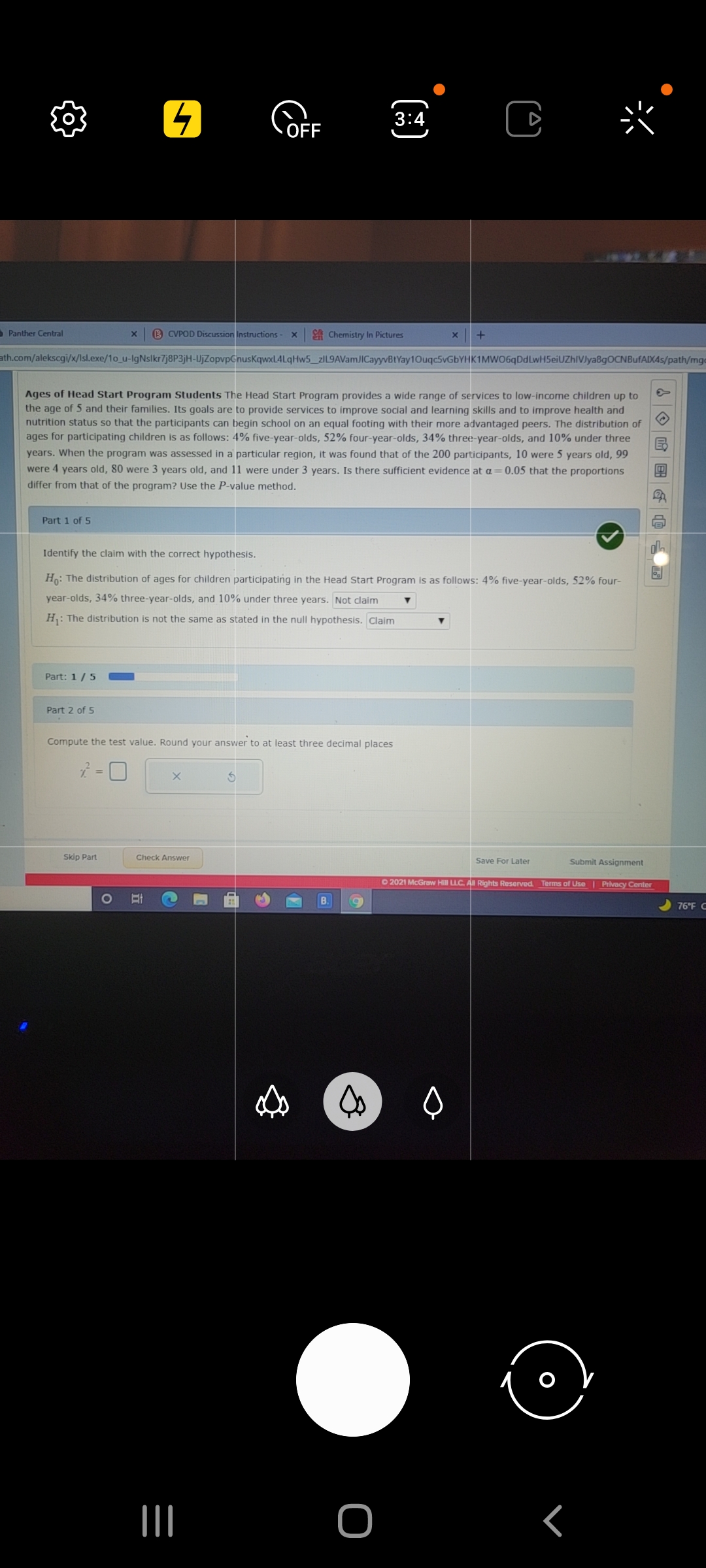Ages of Head Start Program Students The Head Start Program provides a wide range of services to low-income children up to the age of 5 and their families. Its goals are to provide services to improve social and learning skills and to improve health and nutrition status so that the participants can begin school on an equal footing with their more advantaged peers. The distribution of ages for participating children is as follows: 4% five-year-olds, 52% four-year-olds, 34% three-year-olds, and 10% under three years. When the program was assessed in a particular region, it was found that of the 200 participants, 10 were 5 years old, 99 were 4 years old, 80 were 3 years old, and 11 were under 3 years. Is there sufficient evidence at a=0.05 that the proportions differ from that of the program? Use the P-value method. Part 1 of 5 Identify the claim with the correct hypothesis. Ho: The distribution of ages for children participating in the Head Start Program is as follows: 4% five-year-olds, 52% four- year-olds, 34% three-year-olds, and 10% under three years. Not claim H: The distribution is not the same as stated in the null hypothesis. Claim Part: 1/5 Part 2 of 5 Compute the test value. Round your answer to at least three decimal places
Ages of Head Start Program Students The Head Start Program provides a wide range of services to low-income children up to the age of 5 and their families. Its goals are to provide services to improve social and learning skills and to improve health and nutrition status so that the participants can begin school on an equal footing with their more advantaged peers. The distribution of ages for participating children is as follows: 4% five-year-olds, 52% four-year-olds, 34% three-year-olds, and 10% under three years. When the program was assessed in a particular region, it was found that of the 200 participants, 10 were 5 years old, 99 were 4 years old, 80 were 3 years old, and 11 were under 3 years. Is there sufficient evidence at a=0.05 that the proportions differ from that of the program? Use the P-value method. Part 1 of 5 Identify the claim with the correct hypothesis. Ho: The distribution of ages for children participating in the Head Start Program is as follows: 4% five-year-olds, 52% four- year-olds, 34% three-year-olds, and 10% under three years. Not claim H: The distribution is not the same as stated in the null hypothesis. Claim Part: 1/5 Part 2 of 5 Compute the test value. Round your answer to at least three decimal places
MATLAB: An Introduction with Applications
6th Edition
ISBN:9781119256830
Author:Amos Gilat
Publisher:Amos Gilat
Chapter1: Starting With Matlab
Section: Chapter Questions
Problem 1P
Related questions
Question

Transcribed Image Text:3:4
OFF
Panther Central
B CVPOD Discussion Instructions
A Chemistry In Pictures
ath.com/alekscgi/x/Isl.exe/1o_u-IgNslkr7j8P3jH-UjZopvpCnusKqwxLALqHw5_zlL9AVamJICayyvBtYay10uqc5vGbYHK1MWO6qDdLwH5eiUZhIVlya8gOCNBufADX4s/path/mge
Ages of Head Start Program Students The Head Start Program provides a wide range of services to low-income children up to
the age of 5 and their families. Its goals are to provide services to improve social and learning skills and to improve health and
nutrition status so that the participants can begin school on an equal footing with their more advantaged peers. The distribution of
ages for participating children is as follows: 4% five-year-olds, 52% four-year-olds, 34% three-year-olds, and 10% under three
years. When the program was assessed in a particular region, it was found that of the 200 participants, 10 were 5 years old, 99
were 4 years old, 80 were 3 years old, and 11 were under 3 years. Is there sufficient evidence at a=0.05 that the proportions
differ from that of the program? Use the P-value method.
Part 1 of 5
Identify the claim with the correct hypothesis.
Ho: The distribution of ages for children participating in the Head Start Program is as follows: 4% five-year-olds, 52% four-
year-olds, 34% three-year-olds, and 10% under three years. Not claim
H: The distribution is not the same as stated in the null hypothesis. Claim
Part: 1/5
Part 2 of 5
Compute the test value. Round your answer to at least three decimal places
Skip Part
Check Answer
Save For Later
Submit Assignment
02021 McGraw Hill LLC. A Rights Reserved Terms of Use| Privacy Conter
1O
B.
76 F C
(3)
Expert Solution
This question has been solved!
Explore an expertly crafted, step-by-step solution for a thorough understanding of key concepts.
This is a popular solution!
Trending now
This is a popular solution!
Step by step
Solved in 2 steps with 3 images

Recommended textbooks for you

MATLAB: An Introduction with Applications
Statistics
ISBN:
9781119256830
Author:
Amos Gilat
Publisher:
John Wiley & Sons Inc

Probability and Statistics for Engineering and th…
Statistics
ISBN:
9781305251809
Author:
Jay L. Devore
Publisher:
Cengage Learning

Statistics for The Behavioral Sciences (MindTap C…
Statistics
ISBN:
9781305504912
Author:
Frederick J Gravetter, Larry B. Wallnau
Publisher:
Cengage Learning

MATLAB: An Introduction with Applications
Statistics
ISBN:
9781119256830
Author:
Amos Gilat
Publisher:
John Wiley & Sons Inc

Probability and Statistics for Engineering and th…
Statistics
ISBN:
9781305251809
Author:
Jay L. Devore
Publisher:
Cengage Learning

Statistics for The Behavioral Sciences (MindTap C…
Statistics
ISBN:
9781305504912
Author:
Frederick J Gravetter, Larry B. Wallnau
Publisher:
Cengage Learning

Elementary Statistics: Picturing the World (7th E…
Statistics
ISBN:
9780134683416
Author:
Ron Larson, Betsy Farber
Publisher:
PEARSON

The Basic Practice of Statistics
Statistics
ISBN:
9781319042578
Author:
David S. Moore, William I. Notz, Michael A. Fligner
Publisher:
W. H. Freeman

Introduction to the Practice of Statistics
Statistics
ISBN:
9781319013387
Author:
David S. Moore, George P. McCabe, Bruce A. Craig
Publisher:
W. H. Freeman